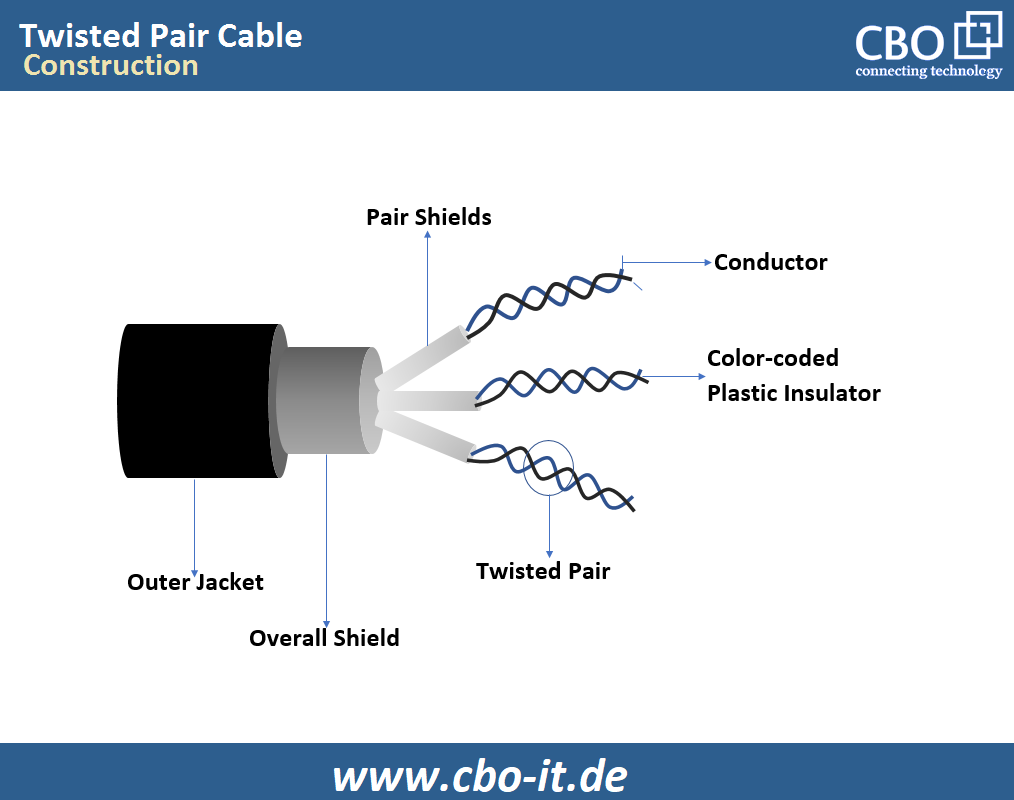A twisted pair cable is a networking Ethernet cable consisting of two insulated conductive wires in a twisted pattern. In a twisted pair cable, the set of wires run parallel to each other – a feature that helps improve electromagnetic compatibility.
In twisted wires, some noise signals go in one direction (sending) while the remaining noise signals go in the opposite direction (receiving). This method helps reduce the undesired impact of the magnetic field, and the effect of the external waves can be minimized due to different twists.

In simple terms, a twisted pair cable reduces the electromagnetic radiation between adjacent joints and improves the resistance to external electromagnetic interference, compared to a straight-pair cable. According to the EIA / TIA-568 standard, twisted pair cables can be classified into various types based on their electrical characteristics, such as;
- Cat5e
- Cat6
- Cat7
- Cat8
Shielded vs. Unshielded Twisted Pair Cables
Shielding helps in strengthening the cable`s noise immunity. Cables with shielding are called “Shielded Twisted Pair Cables” or STP cables. At the same time, cables without this feature are known as “Unshielded Twisted Pair” or UTP cables. The following passages contain detailed information about the difference between UTP and STP cables.
Unshielded Twisted Pair (UTP) Cable
UTP cables are low-cost networking cables made with a set of twisted, insulated conductors contained in a plastic jacket for protection. There is no foil cover or braided shielding, which makes the wire smaller in diameter. 24 AWG is the most commonly used UTP wire gauge. Some vendors offer even thinner cable - the Cat6 28AWG Slim cable, which supports 250MHz bandwidth and 1000 -T Ethernet, allowing more secure data transmission. Lightweight UTP cables are easily secured through narrow spaces and cable management panels, which help improve airflow and reduce the risk of network damage.
UTP cable application
In addition to its use in Ethernet networks and many telephone systems, UTP is one of the most common cables used in computer networks. Because UTP cable bandwidth has been optimized to match the band of the TV signal, UTP is used in some video applications, especially security cameras.
Advantages of UTP Cable
- it is less expensive than other types of communication media.
- It is the most compatible type of cabling that can be used with many types of networking systems.
- Small in size. Therefore, the installation is easy because it does not fill the wiring harness.
- It does not require grounding
Shielded Twisted Pair (STP) Cables
Unlike UTP cables, STP cables comes with an additional foil cover or copper jacket. Shielding prevents the signal flowing through the wires from interference, resulting in data transmission at higher rates than UTP. The STP cable works by attracting interference through its shield then disposing of it into a grounding system. Various type of shielded twisted pair cables is available on the market, including;
Foil Twisted Pair (FTP) - With FTP cables, each twisted pair of wires shielded by a foil for prevention against crosstalk and EMI
Shielded / Foil Twisted Pair (SFTP) - Cable classified as Shielded Foil Twisted Pair (S / FTP) comes with a combination of STP and FTP shielding. The twisted wires inside the cable are protected with a foil wrapping. Moreover, each 4-pair group of foiled wires is shielded through a flexible breaded screen or a foil. Double shielding in SFTP type cables offers the highest possible level of prevention against crosstalk and EMI.
STP cable application
STP cables are widely used in computer and telephone networks, including ethernet connections for computer networks and residential and commercial telephone communications. Because STP cables are long-lasting and durable with excellent shielding characteristics, they can also be used in industrial sectors where cables remain subject to high electromagnetic interference.
Advantages of STP cables
- Shielding minimizes the chance of crosstalk
- Shielding offers maximum protection from interference
- These cables can handle data transmission at higher rates
- Secure transmission of data is possible with STP cables
Conclusion
Twisted pair cable is one of the most uncomplicated networking or signals transmission mediums available. It is considered a better choice than other available cables because it tends to cancel out external interference. We have discussed the two available types of twisted pair cables; STP and UTP. Both shielded and unshielded twisted pair cables have some pros and cons. Shielded cables are offered with additional protection against emf, but they cost more than the unshielded cables. For everyday applications in settings with minimal risk of external interference, one can also use cheaper, unshielded twisted pair cable.
 English
English
 Deutsch
Deutsch
 Espaniol
Espaniol










